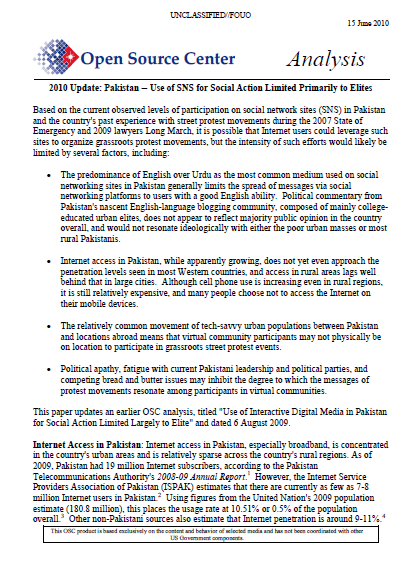 2010 Update: Pakistan — Use of SNS for Social Action Limited Primarily to Elites
2010 Update: Pakistan — Use of SNS for Social Action Limited Primarily to Elites
- 19 pages
- For Official Use Only
- June 15, 2010
Based on the current observed levels of participation on social network sites (SNS) in Pakistan and the country’s past experience with street protest movements during the 2007 State of Emergency and 2009 lawyers Long March, it is possible that Internet users could leverage such sites to organize grassroots protest movements, but the intensity of such efforts would likely be limited by several factors, including:
- The predominance of English over Urdu as the most common medium used on social networking sites in Pakistan generally limits the spread of messages via social networking platforms to users with a good English ability. Political commentary from Pakistan’s nascent English-language blogging community, composed of mainly college-educated urban elites, does not appear to reflect majority public opinion in the country overall, and would not resonate ideologically with either the poor urban masses or most rural Pakistanis.
- Internet access in Pakistan, while apparently growing, does not yet even approach the penetration levels seen in most Western countries, and access in rural areas lags well behind that in large cities. Although cell phone use is increasing even in rural regions, it is still relatively expensive, and many people choose not to access the Internet on their mobile devices.
- The relatively common movement of tech-savvy urban populations between Pakistan and locations abroad means that virtual community participants may not physically be on location to participate in grassroots street protest events.
- Political apathy, fatigue with current Pakistani leadership and political parties, and competing bread and butter issues may inhibit the degree to which the messages of protest movements resonate among participants in virtual communities.
This paper updates an earlier OSC analysis, titled “Use of Interactive Digital Media in Pakistan for Social Action Limited Largely to Elite” and dated 6 August 2009.
Internet Access in Pakistan: Internet access in Pakistan, especially broadband, is concentrated in the country’s urban areas and is relatively sparse across the country’s rural regions. As of 2009, Pakistan had 19 million Internet subscribers, according to the Pakistan Telecommunications Authority’s 2008-09 Annual Report. However, the Internet Service Providers Association of Pakistan (ISPAK) estimates that there are currently as few as 7-8 million Internet users in Pakistan. Using figures from the United Nation’s 2009 population estimate (180.8 million), this places the usage rate at 10.51% or 0.5% of the population overall. Other non-Pakistani sources also estimate that Internet penetration is around 9-11%.
…
Blogs Likely To Remain Peripheral to Mainstream Media in Near Future:
Although a few Pakistani bloggers are also regular columnists in Pakistan’s English-language papers, there is limited discussion of blogs in mainstream Pakistani media, and English-language blogs do not appear to have much, if any, political influence in Pakistan. They do, however, offer the opportunity for like-minded Internet users in Pakistan and abroad to connect with each other and discuss current political topics.
- If Internet access increases in Pakistan, blogs may gain more widespread readership outside of urban centers, but OSC has not yet observed any activities by politicians aimed specifically at bloggers or instances of mainstream media complaining of losing market share to blogs or other social networking sites.
- Many bloggers link extensively to articles published in mainstream media, and their comments often center on whether they agree or disagree with the papers’ stances. Similar to blogs in other countries, traditional media will probably continue to influence bloggers more than the reverse. Some bloggers have also begun to link to clips from popular Urdu-language talk shows that have been uploaded to YouTube.
- Although Pakistan’s most widely-read daily papers are published in Urdu, and most Pakistanis prefer Urdu TV channels, much of the country’s blogosphere is written in English. The slow adoption of Urdu fonts for Unicode has led to mainstream media websites either using an Arabic font or image files instead of text, such as the websites of the Urdu papers the Daily Express, Mashriq, the Daily Taqat, and Khabrain. This discourages hyperlinking and limits the utility of Urdu for sharing information across different social networking platforms.
…
Face-to-Face ‘Meetups/Tweetups’ Strengthening Virtual Social Networks:
Gatherings organized and advertised on free online social networking platforms such as Facebook and Twitter are providing a foundation of Internet communication channels that could help virtual communities in Pakistan organize quickly around a future issue or cause, similar to the student rallies held at universities during the State of Emergency in 2007.
In late 2008, a meetup event in Lahore was organized on Facebook in only three days, according to post-event reports by participants. It was held at the Lahore University of Management Sciences, a site with historical significance for many Pakistani bloggers because it was the scene of mass student protests during the 2007 state of emergency. Word of the event spread on Twitter under the RSS hashtag “#LBM08.” More recently, bloggers and other Internet users met in Karachi on 26 July to explore and share knowledge about Twitter. Participants discussed how Twitter could be used in Pakistan’s socio-political environment and explored potential ways to avoid possible access or censorship restrictions in the future and “talked extensively” about what to do if a situation similar to that in post-presidential elections Iran arose in Pakistan.
